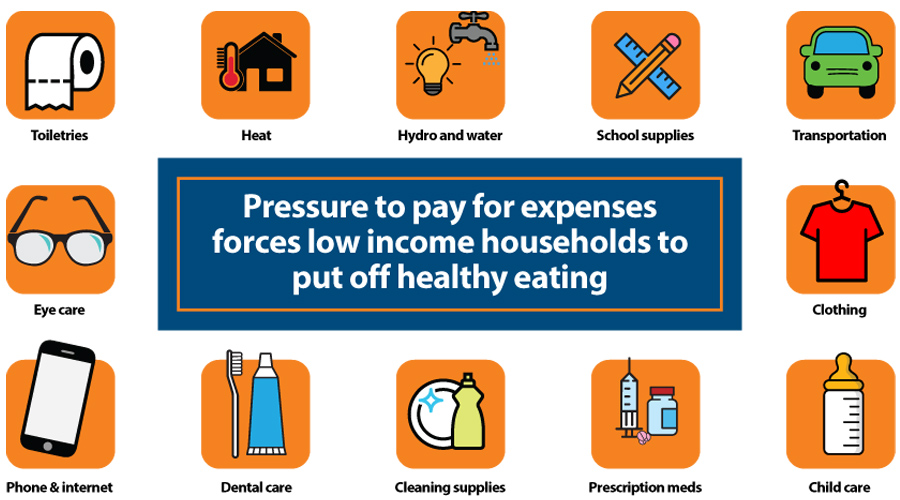
Food Insecurity
What is food insecurity?
Food insecurity is not having enough income to buy food. For many families in Durham Region, being unable to buy nutritious food is a reality. Food insecure households struggle and must choose between paying for food, rent, bills and other basic needs.
For these families, food insecurity means:
- Worrying that food will run out.
- Having to compromise on the type of food they eat or eat less food than they need.
- Skipping meals altogether.
- Eating the same few foods for all their meals.
- Going without eating so their children can eat.
While inflation, and in particular food inflation, continues to increase at very high rates1, for most of Ontario, people with low incomes do not have enough income to cover the costs of basic living, including food.
| Why is food insecurity important? |
|
Food insecurity is a serious public health issue because individuals’ health and well-being are closely linked to household food insecurity.2 People living in food insecure households are much more likely than others to be diagnosed with physical and mental health conditions including, diabetes, oral health problems, cardiovascular disease, anxiety and depression, chronic pain, and infectious diseases. People who are food insecure are less able to manage existing health problems and are more likely to experience poor health outcomes including hospitalization or premature death. Household food insecurity takes a serious toll on the health care system spending costs and resources.3 |
One in four households in Durham is food insecure
Certain social and economic situations increase the risk of experiencing food insecurity.7 There is a higher rate of food insecurity in groups such as:
- single parent female-led households with children;
- households with employment insurance/workers’ compensation or social assistance as the main source of income;
- those living in rental housing, and
- racialized peoples.
Learn about the impact of food insecurity and who is most affected in our Food Insecurity in Durham Region Infographic.
| Who is most affected by food insecurity? |
|
Food insecurity is closely linked to income – with lower household income, the risk of food insecurity increases.4 In 2023, 25 per cent of Durham Region households did not have enough money to buy food.5 Having a job is often not enough. In 2021, 52 per cent of food insecure households in Ontario were in the workforce relying on low-wage employment, short term or precarious work, or working multiple jobs as their main source of income. Low-wage jobs and inconsistent work leave too many workers without enough income to buy food. Among Ontarians who receive social assistance, approximately two-thirds (67.2 per cent) reported food insecurity in 2021. The high rates of food insecurity among households receiving social assistance in Ontario suggest that it fails to meet recipients’ basic needs.6 |
Monitoring food affordability in Durham Region
The price of a basic healthy diet for a family of four
Durham Region Health Department found that in June 2024, the price of a basic healthy diet for a reference family of four in Durham Region was $286 per week or $1,232 per month.
| How we calculate food affordability |
|
Durham Region Health Department uses the Ontario Nutritious Food Basket (ONFB) to survey food prices in grocery stores located throughout Durham Region. The results of the ONFB survey are used to determine if food is affordable for Durham Region residents. The cost of the ONFB and rental housing can be compared to individual and family incomes to determine whether food is affordable. The cost of the ONFB is calculated based on the average lowest cost of 61 food items surveyed in June 2024, based on Canada’s Food Guide (vegetables and fruit, whole grain foods and protein foods) and that reflect Canadian eating and purchasing patterns.2 The ONFB does not include certain types of food and other items such as:
The ONFB also assumes that most people have the time, food skills and equipment to be able to prepare most meals from scratch and have access to quality grocery stores. |
After paying rent and utility bills, what would you do if there wasn’t enough money left to buy nutritious food?
For many Durham Region families this is the reality. When faced with the choice of paying the rent or going hungry, many low-income households are often forced to choose between buying groceries and other necessities.

Moving toward income solutions
Food insecurity is rooted in poverty. Community-based food programs such as food banks, food recovery programs, food skills programs, community kitchens and gardens may provide short-term relief but are not an effective solution in reducing long term food insecurity because they do not increase household income.9
Solutions that reduce food insecurity include:
- Affordable housing, transportation and child care.
- Secure, quality jobs, with living wages and benefits.
- Social assistance programs that provide adequate benefits to cover real costs of living.
| What can you do to help? |
|
Spread the word! Talk to friends, family, and colleagues about the link between income and food insecurity and solutions.
|
| Additional food insecurity resources |
|
|
References |
|
Contact Us




